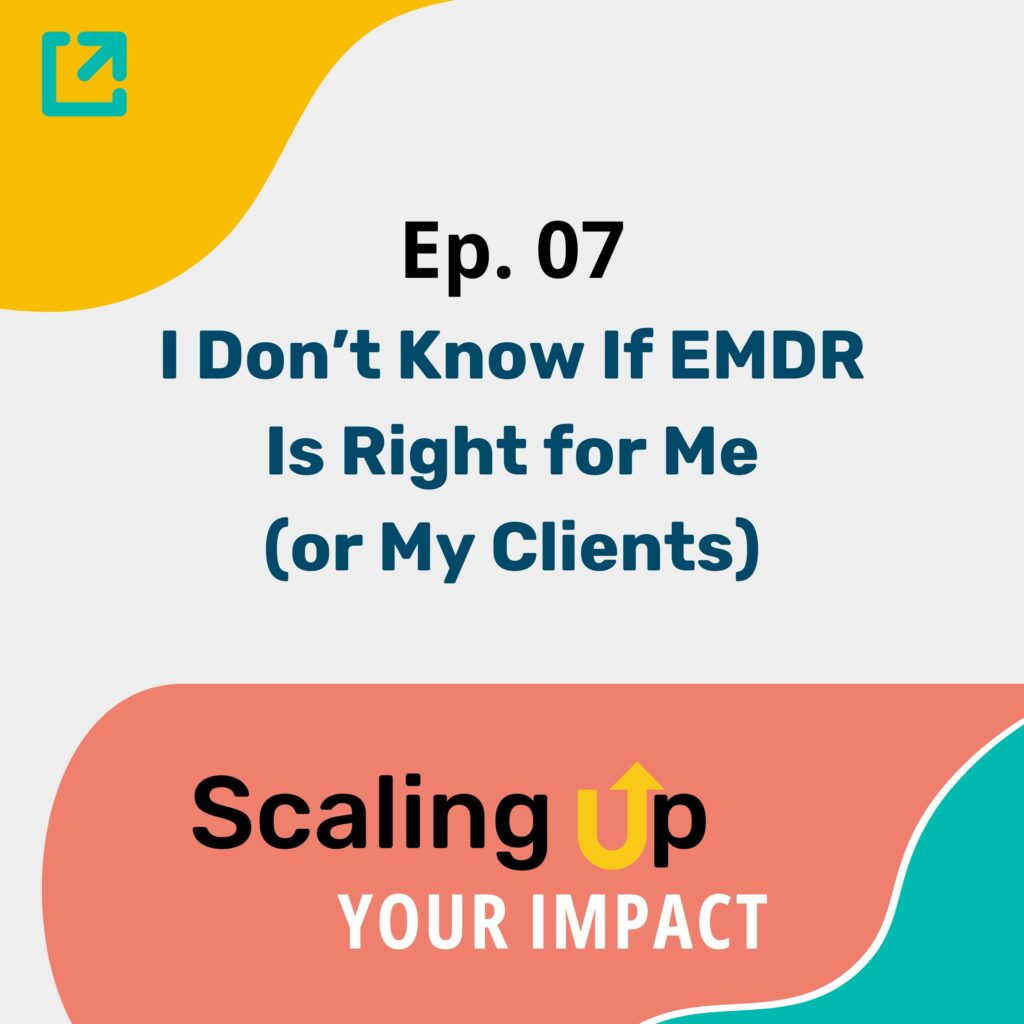Show Notes
Hear more from Nicolle (and Jacqui) about client stabilization and EMDR therapy by watching this brief video – https://www.youtube.com/watch?v=L6cSwJ1OiCs&t=3s
Transcript
Hi there, and welcome back to Scaling Up Your Impact—the podcast for trauma-informed therapists who want to grow their skills, confidence, and reach—without burning out.
I’m Kelly Smyth-Dent, founder of Scaling Up, and today we’re tackling a really common question—one that comes up in just about every EMDR Basic Training cohort, in consultation calls, and even in DMs from therapists we’ve never met:
“I don’t know if EMDR is right for me—or for my clients.”
So maybe less of a question and more of a statement with some curiosity behind it. If you’ve ever been wondering this for yourself—whether it’s because of your client caseload, your therapy style, or your practice setting—you’re not alone. EMDR is kind of a weird therapy, conceptually it sounds really strange and honestly, it can feel kind of strange on the client’s end and the therapist’s end. Let’s break it down and help you figure out if EMDR training makes sense for you.
First off—let’s normalize this hesitation.
Therapists who ask this question are often doing something really important: They’re thinking critically about clinical fit and client care. That’s a good thing.
Some of the most common concerns we hear include:
- “My clients aren’t trauma clients. Would I even use EMDR?”
- “I work mostly with anxiety and depression. Is EMDR only for PTSD?”
- “I’m not a super structured therapist. Will this feel too rigid for me?”
- “I don’t want to retraumatize my clients. Isn’t EMDR intense?”
- Or simply… “I’ve heard EMDR is amazing… but is it really something I’ll use?”If any of these sound familiar, you’re asking exactly the right questions.
When therapists invest in training—time-wise, financially, and emotionally—you want to be sure it aligns with your work and your clients’ needs.
So let’s dig into who actually benefits from EMDR Therapy—both on the client side and the therapist side.
Let’s start with clients.
While EMDR was originally developed for treating PTSD, its use has expanded dramatically over the past few decades.
Here are some client profiles and situations where EMDR tends to be especially effective:
✅ Single-incident trauma:
- Car accidents
- Medical trauma
- Assaults
- Natural disasters
For these clients, EMDR can help reduce intrusive memories, emotional reactivity, and physical symptoms tied to the event—often in fewer sessions than traditional talk therapy.
✅ Complex trauma and developmental trauma:
For clients with childhood abuse, neglect, attachment wounds, or long histories of interpersonal trauma, EMDR offers a phase-based, titrated approach.
Is it fast and linear? No. But it’s one of the few models that lets you honor complexity while still helping clients reprocess stuck material safely over time.
✅ Anxiety, phobias, and performance issues:
Many therapists are surprised to learn that EMDR can be used for present-day triggers and performance anxiety—helping clients with fears of driving, public speaking, or even test anxiety.
✅ Grief and loss:
When grief feels complicated or frozen due to traumatic elements, EMDR can help clients process those pieces — allowing for more adaptive grieving.
✅ Clients with somatic complaints or chronic pain:
For clients with a trauma history who are showing up with body-based symptoms, EMDR can often uncover and target the unprocessed memories that may be driving their pain or medical distress.
✅ Ongoing traumatic stress:
With protocols like EMDR-PRECI, and even group models (EMDR-IGTP), EMDR is increasingly being used with clients living in ongoing crisis situations—first responders, humanitarian contexts, or communities facing chronic violence.
And remember—EMDR is not about forcing clients to relive trauma. It’s about helping the brain and body reprocess stored, unintegrated memories so that present-day events don’t keep hijacking the nervous system.
Now, let’s talk about you—the therapist.
EMDR isn’t just about the clients you serve—it’s about how you want to work.
If you’ve ever felt like:
- “I wish I had more tools when clients feel stuck.”
- “Talk therapy feels like it’s going in circles with this client.”
- “I want a more neurophysiological (aka: brain & body), research-supported intervention for trauma symptoms.”
- “I need a structured method for working with overwhelming material safely.”
- “I want to learn how to help clients heal trauma at the root.”
…then EMDR is absolutely worth considering.
One thing that surprises many therapists is that EMDR doesn’t require you to give up your current clinical style.
- Are you relational? EMDR is too!
- Do you work somatically? EMDR can complement that because it’s also a somatic approach
- Are you an IFS therapist? Plenty of EMDR therapists integrate parts work because they go hand-in-hand.
- Do you do equine assisted therapy? Awesome, blend it with EMDR for an incredible experience.
Many EMDR-trained therapists integrate EMDR with CBT, DBT, art therapy, play therapy—you name it. EMDR doesn’t replace your clinical intuition, it enhances it with a powerful, physiological tool for processing stuck material.
You’ll also gain language for treatment planning that’s phase-based and ethically sound—making it easier to explain your approach to clients, supervisors, and insurance companies.
And let’s be real—client demand for EMDR is growing. More and more clients are asking for EMDR by name, thanks to media coverage, word-of-mouth, and VA and healthcare endorsements.
Having EMDR in your toolbox doesn’t mean you have to use it with every client—but when you do need it, you’ll be ready.
This is another big fear we hear:
“What if my clients aren’t stable enough for EMDR?”
Great question—and it’s one that’s addressed extensively in EMDR Basic Training. The first two phases of EMDR are all about assessment and preparation.
That means:
✅ Identifying dissociation and building stabilization skills
✅ Teaching clients containment and grounding techniques
✅ Strengthening internal resources before any reprocessing begins
You’ll learn how to tailor your pacing, how to know when someone’s ready, and how to pause or titrate the work as needed.
And just to be clear—being EMDR-trained doesn’t mean you’re required to jump into reprocessing with every client. It simply means you’ll have more options when the time is right.
And as Scaling Up trainer Nicolle Mainthow says, “sometimes the most stabilizing thing we can do for clients is EMDR.” We’ll post a link in the show notes giving you more context into what Nicolle means – it’s a transformative conversation.
So… is EMDR right for you and your clients?
If you work with humans who’ve experienced distress—whether it’s trauma, anxiety, grief, or even just being stuck in old patterns—EMDR can be an incredibly valuable addition to your clinical toolkit.
If you’re curious about how EMDR training works—or want to see upcoming dates for our EMDR Basic Trainings—head over to scalingupemdr.com.
And if you’re already EMDR-trained but want to build more confidence, check out our advanced trainings and consultation options.
Thank you for being here—and thanks for doing the work to scale up your impact.
Until next time.



